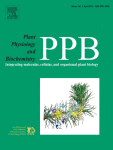Ver ítem
- xmlui.general.dspace_homeCentros Regionales y EEAsCentro Regional Entre RíosEEA ConcordiaArtículos científicosxmlui.ArtifactBrowser.ItemViewer.trail
- Inicio
- Centros Regionales y EEAs
- Centro Regional Entre Ríos
- EEA Concordia
- Artículos científicos
- Ver ítem
Cold acclimation and freezing tolerance in three Eucalyptus species: A metabolomic and proteomic approach
Resumen
The ability of plants to cope with frost events relies on the physiological and molecular responses triggered by cold temperatures. This process, named acclimation, involves reprogramming gene expression in order to adjust metabolism. Planted Eucalyptus species are highly productive but most of them are frost sensitive. However, acclimation process varies among species and environmental conditions, promoting more or less frost damage in young plantations
[ver mas...]
The ability of plants to cope with frost events relies on the physiological and molecular responses triggered by cold temperatures. This process, named acclimation, involves reprogramming gene expression in order to adjust metabolism. Planted Eucalyptus species are highly productive but most of them are frost sensitive. However, acclimation process varies among species and environmental conditions, promoting more or less frost damage in young plantations of frost-prone areas. To identify metabolites and proteins responsible for these differences, two acclimation regimes were imposed to seedling of Eucalyptus grandis Hill ex Maiden (Eg), Eucalyptus dunnii Maiden (Ed) and Eucalyptus benthamii Maiden Cambage (Eb), and leaves submitted to biochemical and molecular analyses. Further, seedlings were used for simulated frosts in order to test the acclimation status effect on frost tolerance. Eb showed higher frost tolerance than Ed and Eg under control and acclimation scenarios, possibly due to its higher accumulation of phenolics, anthocyanins and soluble sugars as well as lower levels of photosynthetic pigments and related proteins. Also, a rise in frost tolerance and in osmoprotectants and antioxidants was observed for all the species due to cold acclimation treatment. Interestingly, metabolic profiles differed among species, suggesting different mechanisms to endure frosts and, probably, different requirements for cold acclimation. Shotgun proteomics reinforced differences and commonalities and supported metabolome observations. An in depth understanding of these responses could help to safeguard planted forests productivity through breeding of tolerant genetic material.
[Cerrar]

Autor
Oberschelp, Gustavo Pedro Javier;
Guarnaschelli, Ana Beatriz;
Teson, Natalia;
Harrand, Leonel;
Podestá, Florencio Esteban;
Margarit, Ezequiel;
Fuente
Plant Physiology and Biochemistry (Available online 26 May 2020)
Fecha
2020-05
Editorial
Elsevier
ISSN
0981-9428
1873-2690
1873-2690
Formato
pdf
Tipo de documento
artículo
Palabras Claves
Derechos de acceso
Embargado
 Excepto donde se diga explicitamente, este item se publica bajo la siguiente descripción: Creative Commons Attribution-NonCommercial-ShareAlike 2.5 Unported (CC BY-NC-SA 2.5)
Excepto donde se diga explicitamente, este item se publica bajo la siguiente descripción: Creative Commons Attribution-NonCommercial-ShareAlike 2.5 Unported (CC BY-NC-SA 2.5)

